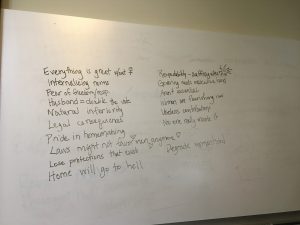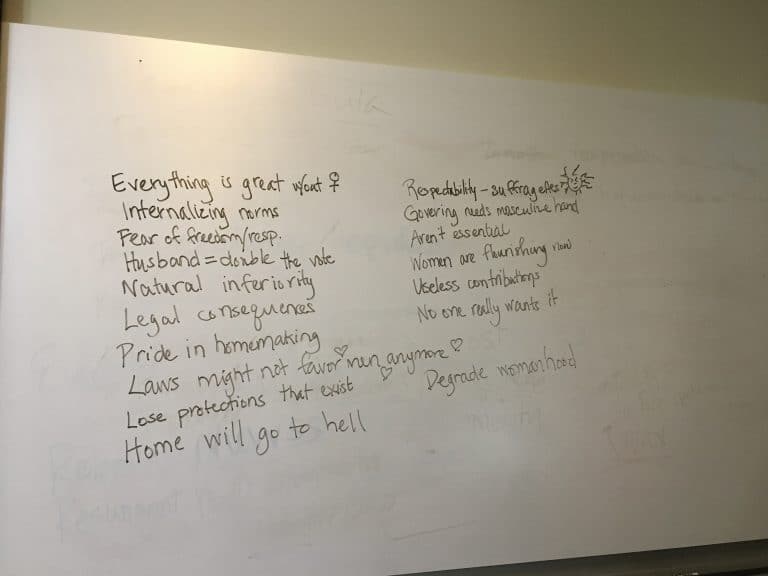 International Women’s Day was first proposed by a socialist and suffragette from Germany named Clara Zetkin in 1910. Two of the colors signifying IWD come from the Women’s Social and Political Union in the United Kingdom: Purple, signifying justice and dignity, and green symbolizing hope. Thus IWD is a direct outgrowth of the European suffrage movement. As it happens, I am teaching a seminar this term focusing on women, gender and sexuality in modern Europe and so the feminist issues of the early 1900s are at the forefront of my thoughts.
International Women’s Day was first proposed by a socialist and suffragette from Germany named Clara Zetkin in 1910. Two of the colors signifying IWD come from the Women’s Social and Political Union in the United Kingdom: Purple, signifying justice and dignity, and green symbolizing hope. Thus IWD is a direct outgrowth of the European suffrage movement. As it happens, I am teaching a seminar this term focusing on women, gender and sexuality in modern Europe and so the feminist issues of the early 1900s are at the forefront of my thoughts.
A few weeks ago my class and I discussed the fight for suffrage, focusing particularly on documents from the United Kingdom because they’re linguistically accessible to my students.
I always find that particular lecture to be incredibly depressing. On one hand of course it is finally a real victory for women, which feels refreshing after months of covering millennia of oppression. On the other hand, discussing the anti-suffrage movement always rings in my mind as an echo of all the reasons Mormons list for why it is fine to exclude women from the priesthood.
I was especially struck by these parallels this year when I had my students create a list of reasons why women shouldn’t be granted the vote based on the anti-suffrage documents we had read. Their list included the following:
- We don’t currently have women in government and things are going great
- Internalized norms
- Fear of freedom/responsibility
- Married women would just double a husband’s vote
- Women are naturally inferior
- There might be negative legal repercussions that go with getting the vote
- Pride in homemaking
- Laws would no longer favor men, especially in terms of sexual freedom
- Lose existing protection
- Home will go to hell
- Suffragettes are not respectable and don’t want to be associated with them
- Governing needs a masculine hand
- Women aren’t essential
- Women are flourishing as it is
- The contributions of women are useless
- No one really wants the vote
- Voting would degrade womanhood.
Some of these do not translate entirely to contemporary LDS struggles, but most do. I will reframe them here to illustrate what I see as the parallels. Why shouldn’t women have the priesthood?
- Women don’t have the priesthood now and the work of God is rolling forward boldly, nobly and independently, penetrating every clime.
- Internalized norms: Priesthood is masculine, and not for me. I’ve never really thought about it.
- I don’t want the priesthood! I have enough on my plate!
- I don’t need the priesthood because I serve in leadership capacities through my husband as Bishop’s Wife/Temple Matron/Mission President’s Wife.
- Women are naturally superior and don’t need the priesthood to keep them on the straight and narrow.
- If I were given the priesthood I might be given a calling I’d never want, like being a Bishop or having a mission become an expected duty.
- I feel honored and special without the priesthood. What if that changes?
- Someone needs to take care of home and children and I see motherhood as the complement to priesthood.
- I see the Ordain Women movement as inappropriate. I have strong negative associations with the word feminist. I do not want to be associated with them.
- Leadership has always been and should be male.
- All ordinances and church organizations can proceed without female involvement and still function correctly.
- I love being a woman in the church and feel supported and valued right now!
- Most women don’t want the priesthood. My wife doesn’t.
- Women wanting the priesthood shows that women don’t understand the special qualities they have.
This list of course is not comprehensive, any more than my students’ list for suffrage covered every possible aspect. However, when we made our list in class it was with some snickers and wry asides. The general tone was “these arguments are ridiculous and offensive and outdated. Thank heavens we don’t live like that.” I hope someday that a history teacher for LDS studies has a similar class about contemporary social attitudes towards excluding women from the priesthood and the students are equally appalled and aghast.






7 Responses
Yes. I’ve noticed these parallels, too. Well, don’t hold your breath.
This is brilliant! It seems so obvious now to see how ridiculous the arguments are laid against women having the vote. And like you, I think the same week arguments about the priesthood ban on women (utterly obtuse!).
This way you’ve laid this out makes a brilliantly contrasting parallel, and a clever way to express how backward the priesthood inequality apoears!
Thank you for this post!
Yep yep yep yep yep yep yep. I was having this exact discussion with a friend the other day, and now I have your post to send to her, laid out much more eloquently than I had!! Thank you!!
I’m 68 and fall under the “norms” description. I’d like more representation and (let’s just say it) power, but I don’t yearn to have the priesthood. We were setting up padded chairs in the RS room today and the high priests took a few of them, while complaining that the chairs would find there way back to the RS room. I said to the former counselor in the SP that they got the priesthood and we got the soft chairs. This did not go over too well.
This is AWESOME.
This is excellent, Em. The parallels are spot on. I totally agree with the hope you expressed at the end. I suspect that once the LDS Church does turn the corner and ordain women, even the most orthodox of members will very quickly be able to see the absurdity of the arguments that they are now happy to advance.